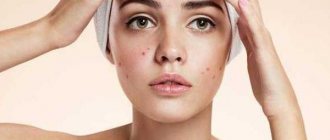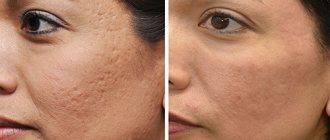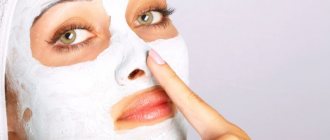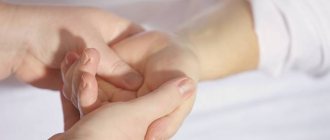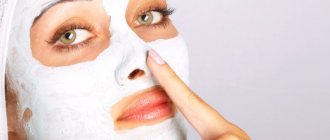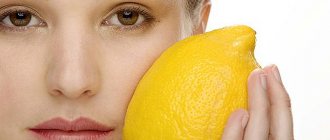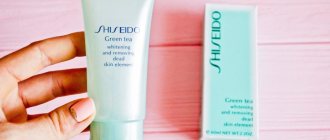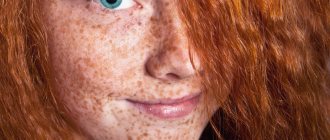AHA and BHA acids have a complex regenerating, anti-inflammatory, comedolytic and pigment-constricting effect. They regulate the functioning of the sebaceous glands, even out the tone and texture of the face. Peeling for problem skin plays an important role in complex acne therapy. The principle of peeling is simple: the drug dissolves horny scales, removes dead cells, and the regeneration process in the dermis is activated. Cells divide at an accelerated rate, the skin is restored with new, young cells. As a result, the skin looks smoother, younger, brighter, healthier.
Characteristics of oily and problem skin
Those with oily skin are more likely than others to face the problem of acne and acne. Excess sebum in the pores is a favorable environment for Propionibacterium acnes bacteria. As they multiply, they provoke an inflammatory process, and acne forms.
Acne dermatosis is a complex polymorphic, multifactorial disease of the sebaceous glands. Today, only the hormonal theory of acne development has been proven.
Mechanism of acne formation:
- Receptors in the dermis react to excess testosterone synthesis and encourage the sebaceous glands to produce sebum.
- If the keratinization process proceeds normally, then excess sebum simply comes out to the surface of the epidermis.
- If the stratum corneum is not regularly exfoliated, then the remaining fat gets stuck in the pores, mixing with dying corneocytes, forming sebaceous plugs or comedones.
- The blocked ducts of the sebaceous glands colonize bacteria, causing inflammation and the formation of a purulent element.
The main cause of acne is endocrine pathology - hyperandrogyny. But modern medical science does not operate with effective methods for correcting hormonal imbalance (only oral contraceptives and diet). Therefore, the most expressive effect is provided by external treatment aimed at speeding up exfoliation.
Peels prevent clogging of pores, free the ducts of the sebaceous glands from excess corneocytes and dissolve existing comedones. Acids also provide an antibacterial and disinfecting effect, even out skin tone and texture by removing a layer of old cells.
Features of the facial peeling procedure
Translated from English, the word “peeling” means “to wash”, “to clean”. Therefore, this event is intended to deeply cleanse the facial skin, remove sebum and impurities, and eliminate dead cells from the surface of the skin.
After exfoliation of the stratum corneum, a renewed, fresh layer of epidermis appears. Young skin better absorbs oxygen and moisture, which normalizes metabolic processes, increases resistance to external negative factors, and improves cell nutrition.
There is an opinion that peeling is just a rejuvenating procedure. However, there are different types of facial peels that have their own characteristics. The basis for its implementation depends on the specifics of a particular procedure. General indications include:
- sagging and sagging skin;
- excessive pigmentation;
- the presence of a thick keratinized upper layer of the epidermis;
- consequences of acne.
Thanks to cleansing, age-related changes become less pronounced. Skin regeneration helps reduce deep or expression wrinkles. Peeling allows you to restore the structure of the skin layer, eliminating defects (microscars, age spots, various scars). In addition, during the procedure, the sebaceous glands and pores are cleansed, it serves as a prevention of inflammatory processes and acne.
Cleaning is not contraindicated for any skin type (dry, normal, oily).
Peeling is a fairly traumatic procedure, so it has a number of limitations:
- overly sensitive skin;
- presence of damage (wounds and abrasions on the face);
- age less than 18 years;
- acute stage of acne or herpes infection;
- pregnancy, lactation;
- tendency to allergies.
Peeling allows you to eliminate various defects and helps maintain healthy, fresh skin. The necessary conditions are the supervision of a professional and the implementation of all recommendations.
Which peels are suitable for acne skin?
If there are inflammatory elements on the skin and the integrity of the epithelium is compromised, then phenol, pure milk and glycolic peels are contraindicated. Other types of procedures can be performed with caution.
Glycolic
Glycolic acid is used carefully to treat acne. It has a small molecular weight, so it penetrates into the deep layers of the dermis.
In this case, not only dead cells of the stratum corneum are destroyed, but also healthy epidermis. In damaged areas, the risk of inflammation increases.
Therefore, acne often worsens after glycolic acid.
Important! To prevent this, it is recommended to use glycolic acid only in combination with other AHAs or use antibiotic creams in post-peel care.
Price: 600–2000 rubles per procedure.
Almond
Often used for problem skin, as mandelic acid has a pronounced anti-inflammatory and disinfectant effect. It is similar in action to the antibiotic Erythromycin, but does not cause resistance in bacteria and acts against all microorganisms (both viruses and fungi too).
Mandelic acid can be applied even to active inflammations.
Price: 2000–5000 rubles per procedure.
Salicylic
Salicylic acid (BHA) is a strong keratolytic; it penetrates pores better than others and dissolves sebaceous plugs. To improve product penetration and reduce discomfort during the procedure, BHA is used in combination with other acids.
Price: 1500–4000 rubles per procedure.
Salicylic acid is a common ingredient in cosmetics for skin with acne and enlarged pores. Manufacturers actively include it in skin care and even decorative cosmetic products. A toner with BHA has a pigment-constricting effect, disinfects the skin and evens out the Ph balance after washing.
Foundation with Salicylic acid also helps to isolate inflammatory elements and dry them out. Popular tones with salicylic acid: Dermablend 3D SPF 25 from Vichy, Anti-Blemish Solutions Makeup from Clinique.
Jessner Peel
A combination drug is used (salicylic acid + lactic acid + resorcinol). This peeling can also be performed for active inflammation. It dries out pimples well, dissolves comedones and exfoliates dead cells.
Jessner's peel can be superficial or medium. The depth of impact depends on the number of layers.
The cosmetologist applies the mixture of acids, and the client washes it off independently after 8–15 hours.
Price: 3500–8000 rub . for the procedure.
"Yellow" peeling
The procedure is carried out using retinoic acid (tretinoin). This is the active form of vitamin A. The procedure is the same as for Jessner.
“Yellow” peeling gives a pronounced result, smoothes the relief, speeds up healing, prevents the appearance of new comedones, narrows pores, and helps even with deep cystic acne.
Attention! “Yellow” peeling can cause aggravation after the procedure, so the cosmetologist prescribes maintenance therapy with tretinoin or antibiotics.
Price: 6500–15000 rub. for the procedure.
Tretinoin in dermatology is the “gold standard” for the treatment of acne. It can be used not in peeling courses, but in daily care. Preparations with tretinoin:
- Retin A (original drug, everything else is generic);
- Renova;
- Acnelyse;
- Retino-A;
- Stieva-A;
- Airol;
- Locacid.
Tretinoin is not certified in the Russian Federation, therefore, only drugs with adapalene (a derivative of retinoic acid) can be purchased in retail pharmacy chains: Differin, Bezugray, Adolen, Effezel.
TCA peeling
Trichloroacetic acid (TCA) is used primarily locally. It is contraindicated to apply to active inflammations. This drug is chosen for severe textural problems, post-acne, and scars. TCA peeling is classified as medium peeling. The rehabilitation period is 1–2 weeks.
Price: 3000–15000 rubles per procedure
We care about your health
Types of facial peels.
If the skin does not receive professional care, it quickly loses its beauty. Peels restore youth and freshness to your face . Doctors-cosmetologists at the Medkvadrat clinic perform all types of modern procedures: cosmetic, hardware and chemical. Specialists work with professional medical equipment and use only certified drugs. The effect of the procedures will be exactly what you expect and what the cosmetologist promises. The skin becomes elastic and smooth, wrinkles and age spots are reduced.
Why do you need facial peels?
Dead epidermal cells and impurities accumulate on the surface of our skin. Excess sebum clogs the pores and prevents her from breathing.
If the skin is not cleansed regularly or incorrectly, the end result is sad:
- Pimples and blackheads appear, wrinkles become more noticeable.
- The skin looks dull, it takes on an unhealthy and uneven color.
- Creams and masks stop working because dead skin flakes do not allow the active ingredients to pass through.
- Decorative cosmetics do not apply well due to uneven skin texture.
The main task of professional peeling is to remove the dead layer of cells and start renewal processes.
General effects:
- beautiful and healthy complexion;
- smooth and soft skin;
- the face is younger and more toned;
- pigment spots lighten;
- small wrinkles disappear, deep wrinkles are smoothed out.
The result of the procedure largely depends on the type of procedure and the depth of impact.
Classification of facial peels:
Based on the depth of impact, all peels are divided into:
- Superficial - act at the level of the stratum corneum of the epidermis and do not affect living cells. Well tolerated. The effect of single procedures is not long-lasting; a course or regular use is required.
- Median - act on living cells of the epidermis, but do not affect the dermis. During the procedure, the patient feels intense heat and burning. The rejuvenating effect of 1-2 procedures lasts 3-6 months.
- Deep - affects living cells of the epidermis and dermis. The patient feels pain during the procedure and for some time after it. They give a pronounced and lasting rejuvenation effect that lasts 2-3 years.
According to the method of exposure to the skin, they are distinguished:
Cosmetic peelings
The procedure involves applying cosmetics with an exfoliating effect:
Scrubs and peelings for mechanical cleansing of the skin
The products consist of a foaming base and an abrasive: ground apricot kernels, crushed sea salt, clay particles, artificial particles.
The scrub is applied generously to clean and damp facial skin, excluding the skin around the eyes and lips. After a light massage, the product is washed off with warm water. The procedure ends with applying a mask or cream according to your skin type.
Peels and masks with fruit acids and enzymes.
Cosmetics contain enzymes (papain, etc.) or AHA acids (malic, citric, glycolic, etc.). Enzyme peels and products with fruit acids do not need to be rubbed into the skin. The active ingredients dissolve the bonds between dead cells and thereby promote their removal from the surface of the skin. They are applied for 15-20 minutes like a regular mask.
To keep your face smooth and clean, cosmetic peeling is carried out 1-2 times a week, in a cosmetologist’s office or at home.
Contraindications:
- exacerbation of acne, herpes virus and other skin diseases;
- wounds and scratches on the skin;
- mechanical peelings are not performed for rosacea and rosacea;
- individual intolerance to the components of the drug.
Our cosmetologists use only professional cosmetics for their work. It differs from the usual one in its high concentration of active substances. This means you will see results after just 1 session. With each procedure, the effect increases: the skin is smoothed, the complexion becomes more beautiful and even.
Chemical peels
Chemical peeling is a professional procedure for cleansing and rejuvenating the skin. Only cosmetologists with medical education have the right to perform it.
The essence of the procedure:
The specialist applies a special composition containing acid or alkali to the prepared facial skin. Penetrating into the skin, the substances cause a local burn, the strength and severity of which is regulated by the cosmetologist. In response to damage, old cells gradually die and slough off.
Peeling usually begins 2-5 days after peeling. The deeper the peeling, the stronger the skin reacts and the more actively new cells are formed.
A few days or weeks after the procedure, the skin looks young, smooth and fresh. Irregularities are smoothed out, pigment spots disappear.
Types of chemical peels
The most effective and popular peelings today:
Almond
Action:
Superficial peeling based on mandelic acid. Gently dissolves dead cells, further soothes and moisturizes the skin. It works great on fine wrinkles, large pores and acne.
Depth:
Due to the large size of mandelic acid molecules, peeling does not penetrate deep into the skin and does not cause severe irritation or peeling.
Peculiarities:
Summer time and thin skin are not absolute contraindications to the procedure.
Salicylic peeling.
Action:
Improves the condition of problematic and oily skin. Cleans, disinfects and soothes. Reduces the severity of post-acne spots and hyperkeratosis. Tightens pores.
Depth of action:
Depending on the concentration, salicylic peels are superficial and superficial-medium.
Glycolic peeling.
Objectives: actively used for rejuvenation and smoothing of skin texture: combating scars, scars, stagnant post-acne spots.
Depth of action:
Glycolic peeling can be superficial, medium and deep. The higher the concentration of glycolic acid, the deeper its effect.
Peculiarities:
Usually not performed on patients with thin and sensitive skin.
Glycolic , almond and salicylic peels are performed once every 10-14 days.
Course – 5-10 procedures.
The effect lasts for several months.
Retinoic peeling.
Objectives: copes remarkably well with age-related skin changes and the consequences of acne.
Depth of action: formally, retinoic peeling is superficial, but in terms of action it is close to medium.
Mechanism of action: the main active ingredient of the drug is retinoic acid. Unlike other chemical acids, it does not damage the skin. The substance acts on cellular receptors and triggers active cell division. More collagen, elastin and hyaluronic acid are formed, which are responsible for skin elasticity and hydration
Peculiarities:
- Retinoic peeling is used for any skin type.
- The effect is visible after the first procedure and lasts 4-5 months.
- To avoid side effects, it is important to properly prepare for the procedure. 2-3 weeks before the session, the patient uses creams with fruit acids. After the session, the doctor prescribes sunscreen and moisturizers and enzyme masks.
Jessner peeling.
Active substances:
Salicylic acid - exfoliates, disinfects and soothes. Lactic acid - triggers the formation of collagen, moisturizes and rejuvenates.
Resorcinol - has an exfoliating effect.
Action:
Smoothes wrinkles, normalizes sebum secretion, tightens pores, lightens pigmentation spots, improves complexion.
Depth of action:
If the drug is applied in a thin layer, it acts superficially. When the cosmetologist applies the composition in several layers, the peeling turns into a medium peeling that affects living cells of the epidermis.
Peculiarities:
- It acts quickly and eliminates aesthetic imperfections for a long time.
- Not suitable for thin and sensitive skin.
- During the procedure, the patient experiences a burning sensation.
- It is carried out once every 1-3 months. The course is selected individually.
How is the chemical peel procedure performed?
| Preparation | The cosmetologist removes makeup and disinfects the skin. |
| Applying peeling agent | Using a brush, a professional peeling composition . Exposure time is on average from 5 to 20 minutes. The cosmetologist carefully monitors the reaction: how red the skin is, how the patient feels. Usually the face feels warm or even burning. |
| Neutralization and rinsing | The doctor neutralizes the composition using a special preparation and washes off the remnants of cosmetics. |
| Disinfection | The skin is treated with an antiseptic. |
| Completion of peeling | A soothing mask or cream is applied. |
Contraindications to chemical peels:
- skin damage;
- tendency to keloid scars;
- exacerbation of skin diseases: psoriasis, eczema, acne, herpes;
- allergy to the components of the drug;
- hypersensitive and very thin skin;
- pregnancy.
Important: Be sure to use sunscreen a chemical peel Otherwise, pigment spots may form.
Hardware facial peels.
Skin cleansing is carried out using special devices: laser, microdermabrasion device, ultrasonic scrubber.
Hardware peels are used to cleanse the skin, smooth out the relief and rejuvenate the face . Just like chemical ones, they are superficial, middle and deep.
One of the most popular hardware procedures is ultrasonic peeling .
Ultrasonic peeling
This is a gentle and painless procedure for superficial skin cleansing. The procedure can be performed at any time of the year and at any age, even teenagers.
Indications for ultrasonic peeling:
- oily skin;
- blackheads and oily shine;
- dryness and flaking;
- tired “stressed” skin;
- dark spots;
- wrinkles.
Mechanism of action:
A working device emits ultrasonic waves. Under the influence of ultrasound, bubbles form in a liquid medium (tonic or gel for ultrasound procedures). They destroy connections between dead cells and clean out pores.
Additionally, ultrasonic waves increase the permeability of the skin to the active substances of cosmetics, improve blood circulation and metabolic processes in tissues.
How the procedure goes:
| Preparation | The cosmetologist removes makeup and cleanses the skin. On a clean face, he applies a professional product (gel or tonic) for ultrasound procedures in an even layer. |
| Peeling with ultrasonic scrubber | A cosmetologist treats the skin of the face using a spatula-emitter. Slowly and without pressure, he moves it across his face against the massage lines. On average, the procedure takes 10-15 minutes. |
| Skin cleansing | The cosmetologist washes off the remnants of a cosmetic product |
| Final stage | Apply a mask or cream according to your skin type. |
Ultrasound peeling result:
- clean and fresh skin;
- even complexion;
- reducing the severity of wrinkles;
- lightening pigment spots;
- beautiful and healthy complexion;
- sebum secretion is normalized;
- enlarged pores become narrower.
After the first session, the skin looks clean and fresh.
For a lasting effect, the procedure is carried out 2-3 times a week. Course: 8-10 procedures.
Contraindications:
- pregnancy;
- infectious process;
- inflammation of the skin and rashes on the face;
- oncology;
- heart and vascular diseases;
- facial paralysis;
- trigeminal neuralgia;
Why are professional peels better than home peels?
The procedures can also be carried out at home. However, in this case, there is a high chance of choosing cosmetics and devices that are not suitable for your skin. At best, there will be no result; at worst, you will harm your skin.
A cosmetologist evaluates the type and condition of the skin. He selects the optimal peeling, tells you how to prepare for the procedure and how to care for your skin after sessions, and recommends professional cosmetics for home care.
professional peeling to renew and rejuvenate the skin , specialists will select other procedures. Our center provides plasma lifting, mesotherapy, biorevitalization and other cosmetic procedures.
Advantages of professional peeling at Medkvadrat:
- Experienced specialists with medical education.
The clinic employs certified cosmetologists with extensive practical experience, including specialists with 15 or more years of experience and candidates of medical sciences.
- Safety of procedures.
Our specialists work with certified drugs and cosmetics. You can see this for yourself. At the patient’s request, doctors present certificates for drugs and diplomas that confirm their qualifications.
Cosmetologists always approach their work responsibly and professionally, so the risk of complications after the procedure is always minimal. Patients' skin remains smooth, fresh and youthful for a long time.
- Affordable prices.
Prices for cosmetic procedures are average in Moscow:
| Cost of services (in rubles) | |
| Retinoic facial peeling | 6050 |
| Retinoic peeling of the area around the eyes | 2850 |
| Almond peeling | 3250 |
| Salicylic peeling | 3850 |
| Jessner Peel | 3650 |
| Chemical peeling of the back (1 zone, 1/3 of the back) | 2700 |
| Chemical peeling of the décolleté area | 3350 |
| Peeling BioRePeel Cl3 | 5500 |
| Peeling with fruit acids “Holy Land” 1 zone (face/neck/décolleté) | 1200 |
| Lactolan peeling “Holy Land” 1 zone (face/neck/décolleté) | 1200 |
| Retinoic facial peeling “Cimel” | 7150 |
| Glycolic peeling | 3250 |
| Chemical peeling TCA 15% | 5500 |
| Chemical peeling TCA 25% | 6050 |
| Peeling PRX T-33 | 5500 |
*prices on the website may differ slightly from the price list.
We regularly hold promotions during which prices for cosmetologist services are significantly reduced. Follow the updates on our website.
make an appointment for facial peeling right now by phone.
For what problems should peeling be used?
Problematic skin can be treated by adjusting your daily care routine to include products with acids or pharmaceutical preparations with tretinoin/adapalene. Peels are used to speed up the results.
But there are problems that can only be solved with the help of peelings:
- blue spots after acne;
- scars, scars after large papules;
- deep, painful cysts, conglobate acne, boils.
Important! Acids affect different stages of acne formation. They accelerate skin renewal and prevent the formation of comedones, dissolve sebaceous plugs and suppress the proliferation of pathogenic microorganisms.
Types of peelings for facial skin
An experienced specialist will help you determine which type of facial peel to choose. The effect of the procedure depends on the depth of exposure of the drugs. The cosmetologist will assess the condition of the skin, the specifics of existing problems and recommend the most suitable option.
Name and description of the main types of facial peeling:
- Superficial peeling. The procedure involves cleaning only the upper layers of the epidermis, without affecting the living layers. The process of superficial peeling removes dead cells. There are practically no contraindications to this procedure, it is painless and does not cause complications.
- Medium peeling. Involves cleaning the entire skin layer. During the session, drugs penetrate deeper into the epidermis, which has a beneficial effect on metabolic processes. Medium peeling is performed only by a professional cosmetologist. After such manipulations, the skin needs intensive restoration.
This type of facial peeling in cosmetology is intended for rejuvenation. It helps eliminate large areas of pigmentation, reduce deep wrinkles, and get rid of old spots. After the procedure, minor burns and red marks remain, so the recovery period can be 3–4 days.
- Deep peeling. Quite a complicated procedure. All manipulations are performed only in a hospital setting with mandatory pain relief. In the process, all layers of the epidermis are destroyed. Tissues begin to regenerate from the remaining fragments.
Deep peeling (laser and chemical) is an aggressive cleaning method. This procedure immediately rejuvenates by 8–10 years, due to the almost complete burning of old skin and its replacement with new one.
The most common anti-aging procedure is medium peeling.
In order to refresh the skin, superficial cleaning is performed at least 2 times a month. To eliminate defects and prevent early age-related changes, medium peeling is performed twice a year.
Indications for deep peeling must be very serious.
There are the following types of peelings for cleansing the skin:
- chemical;
- mechanical;
- ultrasonic;
- laser.
Let's look at each type in more detail.
What effect can be achieved after the procedure?
On oily skin, acne often recurs. It is impossible to completely get rid of the problem without adjusting your lifestyle, diet and skin care. With the help of peelings you can achieve quick results. And to consolidate success, you need to include products with acids in your home care.
Salicylic, TCA, “yellow” and Jessner peels have a pronounced effect of drying out inflammation, reducing sebum production, and narrowing pores. They are preferable for oily skin.
After rehabilitation, the skin looks matte, smooth, small wrinkles and traces of healed inflammation are smoothed out.
For dry skin with inflammation, glycolic, almond, milk, and pyruvic are more suitable. They speed up renewal and healing, even out the tone. Also, acids free the ducts of the sebaceous glands, sebum freely comes out and performs its direct and natural function - moisturizes the epidermis.
Peeling at home
Problem skin does not always react unambiguously to acids. Even some novice cosmetologists are wary of clients with rashes due to the unpredictability of the result.
It is possible to exfoliate acne at home, but you must observe some nuances:
- buy a certified product from a reputable manufacturer and strictly follow the protocol for application, exposure, and neutralization;
- do skin tests for intolerance to the active substance;
- First, carry out the procedure on a small area (for example, only the forehead);
- You can consult a specialist and conduct the first session in the salon, and complete the course at home.
There are many products for home exfoliation on the market - almost every reputable beauty brand produces a line with acids.
Products for home use are sold in cosmetology stores. The advantages of such products: reasonable price, convenient format, clear protocols for use. Plus, each company immediately offers neutralizers, SPF creams, skin preparation and post-peeling care products for the product.
Types of peelings in the salon
To carry out such a procedure in a salon, you first need to visit a cosmetologist. Depending on the condition of the skin and the severity of the problems, the doctor will select the appropriate type of peeling, intensity of exposure, and number of sessions. The cosmetologist will recommend suitable products for home care, since an integrated approach is required to achieve the desired result.
Depending on the depth of impact on the skin, 3 types of peeling are carried out in beauty salons.
- Surface
– only the top layer of dead cells is removed. This method is not very traumatic, recovery from it is quick. But to achieve the desired result, it is recommended to take a course of 4-8 procedures.
- Medium peeling
removes several layers of skin and severely injures it. It helps get rid of more serious problems and normalizes the condition of oily skin for a long time. But it can be carried out no more than 1-2 times a year.
- Deep peeling
- This is a serious, very aggressive procedure. It is carried out in a clinical setting only according to a doctor’s indications.
Which ones are suitable for oily skin?
Depending on the method of influencing the epidermis, mechanical, chemical and hardware peeling is performed in the salon. Not all varieties are suitable for oily skin. The doctor chooses the type of procedure depending on the severity of the problems.
Mechanical exfoliation polishes the top layer of skin. Its task is to cleanse excess sebum and even out the surface. Used if you are prone to acne, have blackheads, or enlarged pores. It is carried out manually using scrubs with abrasive particles or devices. Hardware peeling is microdermabrasion, brossage, ultrasonic cleaning. These methods are contraindicated in the presence of inflammation, acne, or allergies.
Cosmetologists consider chemical peeling using acids to be more effective. For oily skin, several types are usually recommended.
- Almond
best solves problems of increased fat content. It reduces sebum production, has an anti-inflammatory effect, and tightens pores. Mandelic acid can whiten age spots and eliminate acne. Can be used for porous, combination, problem skin. This procedure does not cause severe irritation.
- Salicylic peeling
has a pronounced antibacterial effect, so it is recommended for those prone to acne. This procedure prevents inflammation, reduces the work of the sebaceous glands, cleanses pores, and stimulates collagen production. At high acid concentrations it can cause hyperemia and peeling.
- Yellow retinoic peeling
It is also effective for increased oiliness and a tendency to form acne. The procedure renews the skin, evens out the relief, lightens pigment spots and acne marks.
- Ferul peeling
has a mild effect. Cleanses, prevents hyperpigmentation, has an antioxidant effect. Its advantage is that it can be done in the summer. Ferulic acid protects the skin from UV rays.
- For oily aging skin Combination peelings are recommended
. The combination of salicylic, lactic and citric acid not only relieves inflammation. This procedure eliminates hyperpigmentation, the consequences of cell damage from free radicals.
Precautionary measures
Peeling should not be carried out in case of exacerbation of acne, the presence of purulent pimples, wounds, moles, warts on the face. Contraindications include herpes, dermatitis, psoriasis and other dermatological diseases. Do not peel during pregnancy, breastfeeding or infectious diseases.
Another recommendation, non-compliance with which can lead to undesirable consequences, is that it is better to carry out the procedure in winter or autumn. After salon peeling, it is necessary to protect your face from exposure to UV rays, which can be difficult in the summer.
Post-procedure care
If improper care is taken after the procedure, the skin condition may worsen. Concentrated acids are used in salon peels. Therefore, the following side effects are possible:
- exacerbation of acne;
- exacerbation of herpes;
- the appearance of pigment spots;
- severe redness, swelling;
- scarring.
Such consequences appear if the patient does not follow the cosmetologist’s recommendations. The recovery period, depending on the type of peeling, lasts from 3-5 days to 2-4 weeks. At this time, you need to properly care for your skin. In the first days, it is not recommended to touch your face, apply decorative cosmetics, or go outside without protection from ultraviolet radiation. You can’t scratch or tear off scabs. Daily moisturizing, cleansing and protection is necessary.
To speed up skin recovery after peeling, it is recommended to use creams with antioxidants, vitamin C, aloe extract, and hyaluronic acid. They moisturize the skin, heal, and soothe irritation.
Top home remedies for peeling
Here are the most effective drugs for problem skin, which can be purchased for less than 1,500 rubles:
- Gel with chitosan, based on glycolic acid 10% from MEDICAL COLLAGENE 3D (Russia). Price 700 rub./30 ml.
- Peeling with mandelic acid 5% from ALPIKA (Russia). Price 1500 rub./30 ml.
- AXA 8% / Homework from PREMIUM (Russia). Acids in the composition: glycolic, malic, citric, lactic. Price 900 rub./100 ml.
- Raspberry peeling for oily skin from New Line. Acids in the composition: glycolic (20%), lactic (5%), salicylic. Price 800 rub. for 100 ml.
- Salicylic, retinol, milk, Jessner peels from Home-Peel (Ukraine). Average price - 1500 rubles. for 10 ml.
Also, many products with acids are produced by Korean brands. Korea in the beauty world is perceived as “New France”. Today, almost all innovations come to the market from the South Caucasus.
Acid pads are packages of cotton pads soaked in an acid-containing product. The application procedure is the same as with regular peeling, but the release form is convenient and hygienic. They are produced by the following brands: Missha, Scinic, A'PIEU, Cosrx.
A rolling mask is an excellent alternative to scrubs, which are contraindicated for rashes, as they injure it with abrasive particles and spread the infection to unaffected areas. The roll should be applied in a thin layer to a clean face, wait half a minute and begin to “roll” the mask over the skin. The mask capsules are removed along with dead skin particles. You can use a rolling pad to remove peeling after regular peeling. But this is an optional remedy; it will not help get rid of acne. Rolling masks are produced by the following brands: Secret Key, Ekel, Mizon, Shelim, Tony Moly.
Mechanical facial peeling
This type of manual peeling is considered the easiest way to cleanse the face. The procedure involves mechanical removal of the top layer of the epidermis using abrasives. The preparations used contain hard granules to quickly eliminate dead cells. Such means include:
- Scrub. Available in the form of a gel or cream with abrasive particles. The product is applied to the face, after which it is washed off along with dead cells. It is important to try not to injure the skin during the scrubbing process.
- Gommage. Designed for cellular nutrition and regeneration. The product is a rolling cream with soft abrasive particles or fruit acids that dissolve during cleaning.
- Brushing (brossage) to exfoliate the dead layer of the epidermis. To perform the procedure, you need a special hard brush with synthetic bristles. The face is covered with abrasive paste, then massaged with a brush.
- Salt peeling. The procedure is performed using products containing table or sea salt, rich in macro- and microelements.
- Coral polishing. The products used during the procedure contain coral chips and plant components.
- Film masks for removing dead cells from the skin. The product is a special silicone film that is applied to the face and then removed along with the stratum corneum.
With the help of manual mechanical cleaning, impurities are removed from the surface layer, the skin becomes fresh, and shallow wrinkles are smoothed out.
We recommend
Laser aesthetic cosmetology: the perfect technique for an ideal appearance More
In the beauty salon, specialists perform medium mechanical peeling, which includes microcrystalline dermabrasion and diamond exfoliation. Using these procedures, minor scars, scars, slight pigmentation, and post-acne are eliminated.
Skin care rules after exfoliation
As practice shows, 85% of unpleasant consequences after peeling on problem skin occur due to improper rehabilitation care.
For problem skin, it is always necessary to select creams and serums marked non-comedogenic (do not clog pores). But not all manufacturers care about labeling their products.
Important! Comedogenic components are contraindicated for women with acne, as they can aggravate the situation. Undesirable ingredients: talc, lanolin, alcohol denatured alcohol, oils (castor, cocoa, coconut, wheat germ, peanut, sunflower, soybean), butyl stearate, caprylic acid.
The skin, cleansed, renewed, thinned after peeling, absorbs all care products well. It is important to double-check all household cosmetics to avoid causing acne relapse.
The peeling product itself may contain risky ingredients. The exposure time of the product on the skin is too short for the pores to become clogged.
After glycolic and “yellow” peeling, cosmetologists can prescribe a cream with antibiotics (erythromycin, synthomycin, clindamycin) for an anti-inflammatory effect.
To speed up skin renewal, it is advisable to use ointments or mousses with panthenol, hyaluronic serums, and nourishing creams with safe oils.
You need to choose sun protection products especially carefully, preferably with physical or mineral SPF filters (zinc oxide, titanium dioxide). UV protection is a mandatory step in skin care after peeling.
Preparation for the procedure
For 14 days before peeling, you should not visit the bathhouse, swimming pool, solarium or sauna, or use scrubs and gels for deep cleansing.
How does peeling work?
- First, the doctor removes makeup and degreases the skin with a special lotion or tonic.
- Then apply salicylic acid to the prepared skin. The exposure time is several minutes.
- The doctor neutralizes the acid with alkali or simply washes it off with water.
- A nourishing soothing mask or cream is applied to the skin.
Precautionary measures
Fruit peels are not recommended for active inflammation. If you have fresh acne, it is better to prefer salicylic, retinoic or Jessner.
All peels are contraindicated during pregnancy and breastfeeding, or during the acute stage of herpes. If you have kidney or liver failure, diabetes, or problems with the thyroid gland, you should consult a specialized doctor before the procedure.
After the procedure, be sure to follow the rules of hygiene: wash makeup brushes, use disposable towels, wipe your mobile phone with alcohol, change your pillowcase to prevent infection on the renewed skin.
Alternatives to contraindicated peels
If acid peels are directly contraindicated, acne can be treated with enzyme peels - with papain, bromelain, quinoa extract. These are gentle procedures that do not provoke photosensitivity.
Medical Collagene has a good selection of enzyme gels (up to 800 rubles).
Another alternative option for exfoliation and acne treatment is azelaic acid. It is not included in peels, but is considered a relatively safe remedy for problem skin. Preparations with azelaine: Skinoren, Azogel, Azik-derm.
Patient reviews
The forums are full of positive reviews about peelings from owners of problem skin. This is truly one of the few effective acne treatments.
Girls who did not carefully select the drug and type of peeling complained about the lack of the desired effect.
Girls who were not warned about post-procedure care tactics speak negatively about the procedure.
When is this procedure needed?
We recommend booking a salicylic peel in the following cases:
- You have very oily or breakout-prone skin, and regular products won't help.
- You are tormented by acne and its consequences.
- The skin has lost its former elasticity, become flabby, folds and wrinkles have formed.
- You want to get rid of freckles or age spots.
The best time for peeling is autumn and winter. There is very little sun during this period, and your skin will be in less danger than in summer. In addition, peeling will be an excellent prevention of unwanted pigmentation.
